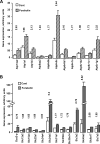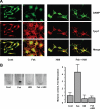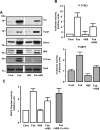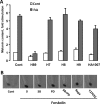{alpha}MSH and Cyclic AMP elevating agents control melanosome pH through a protein kinase A-independent mechanism
- PMID: 19389708
- PMCID: PMC2707200
- DOI: 10.1074/jbc.M109.005819
{alpha}MSH and Cyclic AMP elevating agents control melanosome pH through a protein kinase A-independent mechanism
Abstract
Melanins are synthesized in melanocytes within specialized organelles called melanosomes. Numerous studies have shown that the pH of melanosome plays a key role in the regulation of melanin synthesis. However, until now, acute regulation of melanosome pH by a physiological stimulus has never been demonstrated. In the present study, we show that the activation of the cAMP pathway by alphaMSH or forskolin leads to an alkalinization of melanosomes and a concomitant regulation of vacuolar ATPases and ion transporters of the solute carrier family. The solute carrier family members include SLC45A2, which is mutated in oculocutaneous albinism type IV, SLC24A4 and SLC24A5, proteins implicated in the control of eye, hair, and skin pigmentation, and the P protein, encoded by the oculocutaneous albinism type II locus. Interestingly, H89, a pharmacological inhibitor of protein kinase A (PKA), prevents the cAMP-induced pigmentation and induces acidification of melanosomes. The drastic depigmenting effect of H89 is not due to an inhibition of tyrosinase expression. Indeed, H89 blocks the induction of melanogenesis induced by LY294002, a potent inhibitor of the PI 3-kinase pathway, without any effect on tyrosinase expression. Furthermore, PKA is not involved in the inhibition of pigmentation promoted by H89 because LY294002 induces pigmentation independently of PKA. Also, other PKA inhibitors do not affect pigmentation. Taken together, our results strengthen the support for a key role of melanosome pH in the regulation of melanin synthesis and, for the first time, demonstrate that melanosome pH is regulated by cAMP and alphaMSH. Notably, these are both mediators of the response to solar UV radiation, the main physiological stimulus of skin pigmentation.
Figures







References
-
- Hearing V. J. (1999) J. Investig. Dermatol. Symp. Proc. 4, 24–28 - PubMed
-
- Hearing V. J. (2005) J. Dermatol. Sci. 37, 3–14 - PubMed
-
- Ortonne J. P. (2002) Br. J. Dermatol. 146, Suppl. 61, 7–10 - PubMed
-
- Buscà R., Ballotti R. (2000) Pigment Cell Res. 13, 60–69 - PubMed
-
- Cui R., Widlund H. R., Feige E., Lin J. Y., Wilensky D. L., Igras V. E., D'Orazio J., Fung C. Y., Schanbacher C. F., Granter S. R., Fisher D. E. (2007) Cell 128, 853–864 - PubMed
MeSH terms
Substances
LinkOut - more resources
Full Text Sources
Other Literature Sources
Research Materials
Miscellaneous

